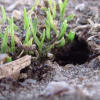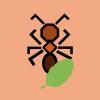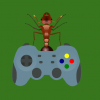Oh; yeah makes sense now.These are some good points which do indeed suggest a Dorymyrmex queen. I do have to say that her head (even without comparing to her gaster) does seem longer than a D. insanus queen, but despite this she is most definitely a Dorymyrmex queen. As stated before it will be very helpful if we could get an image of the worker, or some more close up images showcasing both a side and top view again, to properly view the ant in question.
The head length is in very normal proportions to the standard D. "insanus" gynes. I do agree better images of the gyne would be of aid.
This I’ve seen it in some pics. They have a very light orange color on the tips of their legs (at least for the queen). But based on what you are saying: I guess that’s just some kind of variant.Just a guess. Perhaps V. pergandei based on the orange legs you provided in the description.
Just wanted to ask where you've seen orange-legged Veromessor pergandei.
The apical tarsi segments appearing lighter in color is simply due to how thin the segments are. There is no known variants of V. pergandei which has close to a century of rather in-depth research done on the species.
- Formiculture.com
- Forums
- Gallery
- Members
- Member Map
- Chat

















